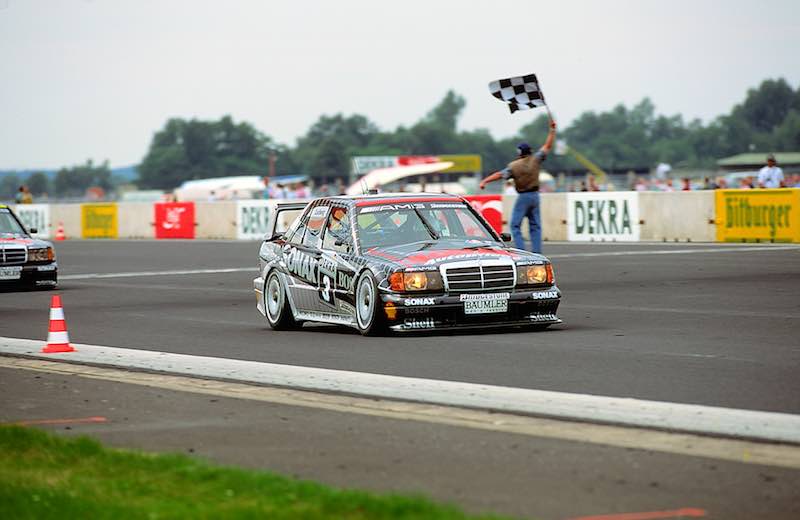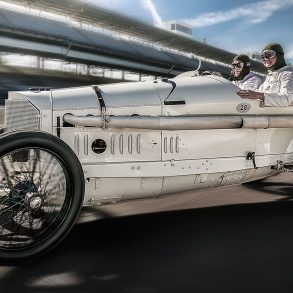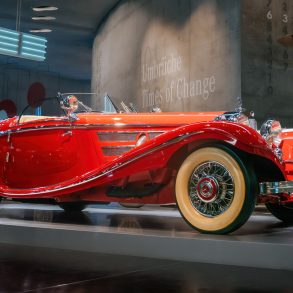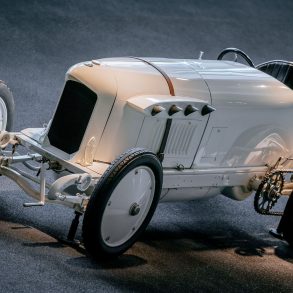On 18 June 1992, Klaus Ludwig driving an AMG-Mercedes 190 E 2.5-16 Evolution II won both races of the German Touring Car Championship at the Nürburgring. This double victory was Ludwig’s first triumph in a season he was to finish as DTM champion. An equally masterly performance was delivered in 1992 by the AMG-Mercedes 190 E 2.5-16 Evolution II racing tourer as Mercedes-Benz drivers won a total of 16 out of 24 DTM races. It was the most successful year in DTM for the AMG racing tourer, which was based on the Mercedes-Benz W 201 model series. Mercedes-Benz also produced a small number of ‘street legal’ examples of the 190 E 2.5-16 Evolution II.
It was 25 years ago that Mercedes-Benz taught the world of motorsport a lesson in evolution theory. The AMG-Mercedes 190 E 2.5-16 Evolution II racing tourer, which was based on the W 201 compact class, more than emphatically dominated the 1992 season of the German Touring Car Championship (DTM): on twelve competition days with a total of 24 races, Mercedes-Benz drivers brought home 16 victories, 17 second places and 13 third places. Klaus Ludwig was crowned German Touring Car Champion, while AMG-Mercedes won the 1992 constructors’ championship. Mercedes-Benz driver Roland Asch was runner-up, with his brand colleague Bernd Schneider taking third place. Ellen Lohr won the first race at the Hockenheimring on 24 May 1992. It was the first and still only DTM victory for a female driver.
In 1992, there was no end of DTM successes for the racing tourer known simply as “EVO II” to the fans: already at the season opener in Zolder on 5 April (Bergischer Löwe), Mercedes-Benz driver Kurt Thiim came first in both races. This was followed by victories for Roland Asch (19 April, Eifel Race at the Nürburgring), Jörg van Ommen and Keke Rosberg (3 May, Wunstorf Airfield Race), Bernd Schneider (10 May, AVUS Race) as well as Ellen Lohr and Roland Asch (24 May, Racing Festival at the Hockenheimring).


Then, at the 24-Hour Race at the Nürburgring on 18 June 1992, Klaus Ludwig posted his first two victories of the season. At the Diepholz Airfield Race on 16 August, the same driver, known as “King Ludwig” to his fans, repeated his double triumph. The culmination of this outstanding season for Mercedes-Benz saw two victories for Bernd Schneider in the ADAC Prize Singen on 6 September as well as one victory each for Schneider and Ludwig in the Touring Car Grand Prix at the Nürburgring on 20 September.
The 1992 DTM year also marked the first high point in the cooperation between the Stuttgart-based brand and AMG, a company specialised in optimising Mercedes-Benz cars for the race track. AMG had been competing in the DTM since 1986 with racing tourers based on the W 201. In 1988, there was the start of direct cooperation between the automotive manufacturer and its partner, which was founded in 1967 as an “engineering office – design and testing for the development of racing engines”. A continuous process of evolution spawned an entire family of successful racing tourers based on the W 201. The DTM team established in 1988 gave rise to today’s Mercedes-AMG DTM team, which uses all six Mercedes-AMG C 63 DTM competition vehicles of the current German Touring Car Masters. Since the start of its involvement in DTM, Mercedes-AMG Motorsport has contested over 400 races in DTM and ITC. Today, the performance brand Mercedes-AMG is a wholly owned subsidiary of Daimler AG.
The fact that, in 1992, Klaus Ludwig with his double victory at the Nürburgring got off to a flying start on his way to the DTM championship was consistent with the history of his racing tourer: the first high-performance version of the W 201 had already given a sparkling show at the legendary racing circuit in the Eifel region back in 1984 — for the official inaugural race at the new Nürburgring on 12 May 1984, Mercedes-Benz made available 20 identical vehicles of the 190 E 2.3-16.




Just a few days previously, the new, decidedly sporty compact-class model had been presented to the press at a trial drive on the newly designed circuit. The starting grid included 20 former Nürburgring winners who had triumphed either in the German Grand Prix or in the 1000 Kilometre Race. The list of names reads like a “who’s who of motor sport”, with the field including Jack Brabham, Hans Herrmann, Phil Hill, Denis Hulme, James Hunt, Alan Jones, Niki Lauda, Klaus Ludwig, Stirling Moss, Alain Prost, Keke Rosberg, Jody Scheckter, Ayrton Senna and John Surtees. Technically and visually, the competing 190 E 2.3-16 models were extensively the same as their standard-production counterparts. The opening race was won by the then 24-year-old Ayrton Senna, who had already made a name for himself as a great up-and-coming talent in Formula One.
In 1985, the 190 E 2.3-16 qualified for homologation (regulation under which a vehicle for racing competitions must be produced in a minimum number of units in order to be classified in a certain competition category) for Group A and N races. Of particular importance for Mercedes-Benz was the international German Touring Car Championship. Using the 190 E 2.3-16 with an output of up to 188 kW (255 hp), in 1986 it was initially some private teams, including AMG, that took part in the Group A Championship. In 1988, no fewer than five teams with factory support from Mercedes-Benz competed in the DTM. That season, which also saw Mercedes-Benz enter a works team in Group C, finally marked the Stuttgart brand’s return to motor sport.
Based on the Mercedes-Benz 190 E 2.3-16, the 190 E 2.5-16 Evolution for the 1989 season was a high-performance variant for DTM racing. The 2.5-litre 16-valve engine had an output of up to 243 kW (330 hp). Weight-reducing measures included the production of body parts such as bonnet, boot lid and spoiler from extremely tear-resistant synthetic-fibre material of exceptional tensile strength. In 1990, there followed the AMG-Mercedes racing tourer 190 E 2.5-16 Evolution II, the engine of which now delivered 274 kW (373 hp). To comply with the homologation rules, as with the first Evolution model, a small volume of 502 units was produced at the Mercedes-Benz plant in Bremen. While AMG was responsible for optimising and equipping the racing cars, the remainder of the vehicles went on open sale as sporty high-performance saloons. Today, they count among the especially sought-after young classic cars of the Mercedes-Benz brand from the 1980s and 1990s era.

[Source: Daimler AG]











Thanks for the article about the 2.3 16. I bought the first car into the US in 1984. The car came by plane for the LA autoshow. Had a tough time meeting Calif. smog and safety requirements. I still have the car with 90,000 miles on it . No major problems ever.. Don